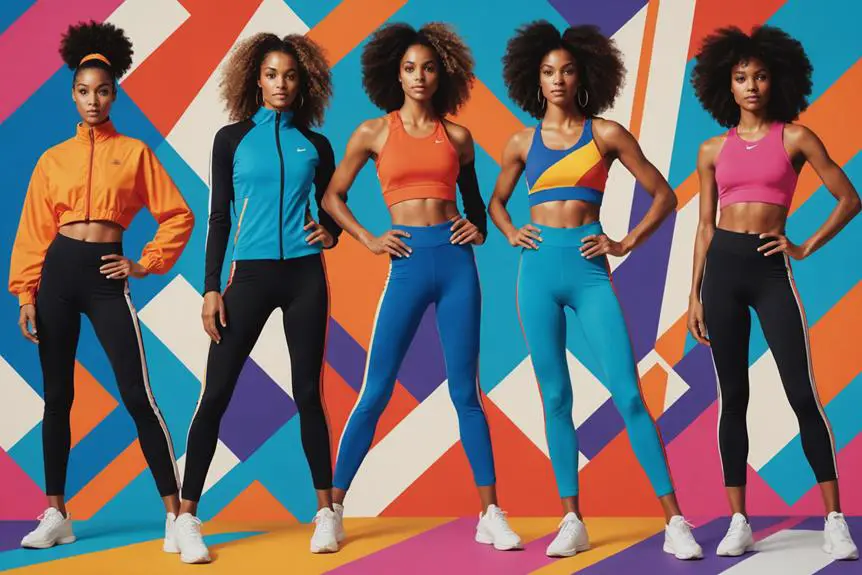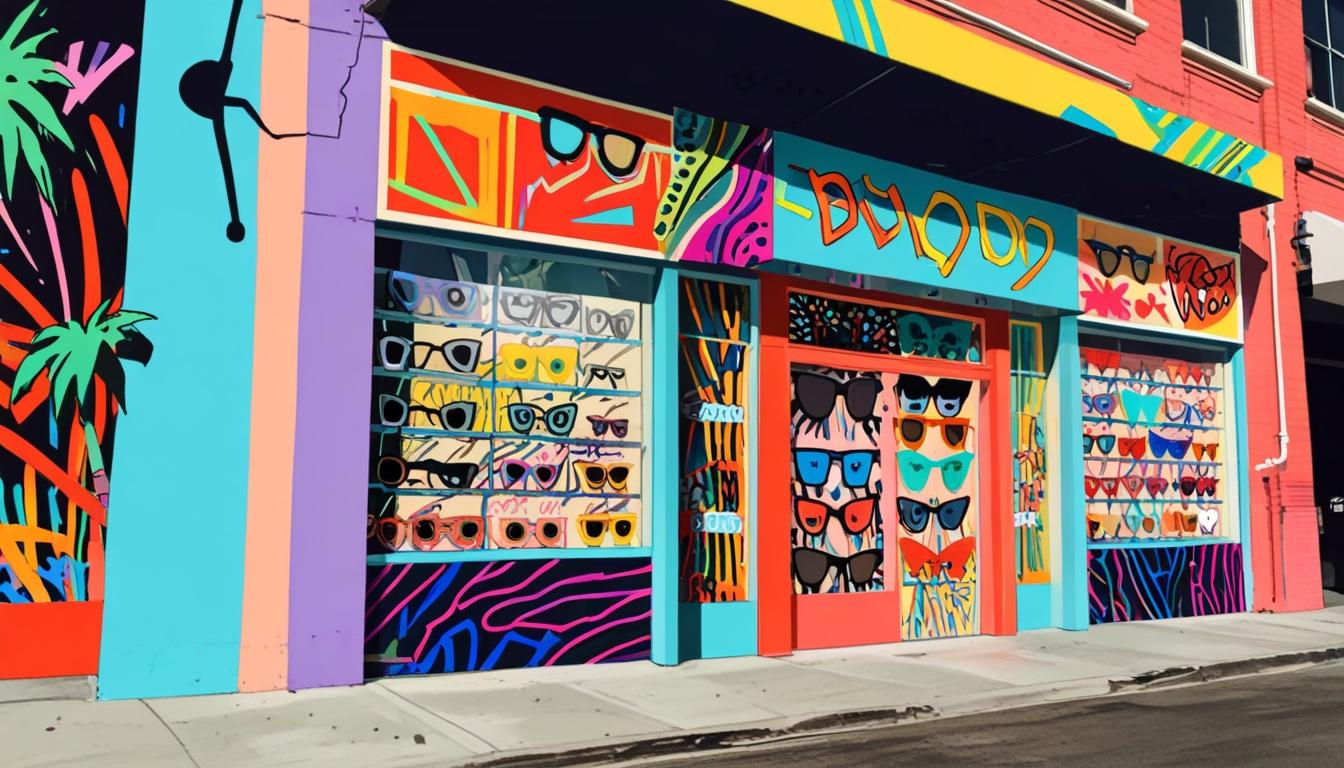When you consider the evolution of activewear, it's intriguing to see how far functional clothing has come since the 19th century. You might think about the restrictive designs that once dominated women's sportswear and contrast that with today's innovative fabrics and styles. As societal attitudes shifted, so did the purpose and aesthetic of athletic attire, paving the way for trends like athleisure. But what's fueled this transformation, and how have key designers influenced this journey? The answers might surprise you and reveal more than just fashion.
Origins of Athletic Wear
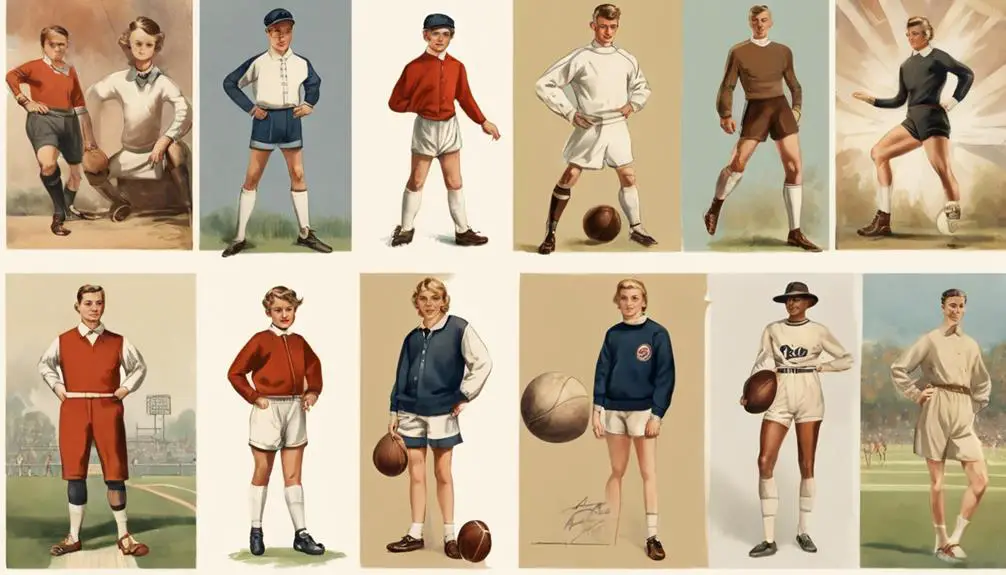
Athletic wear has a fascinating history that dates back to the 19th century. The origins of athletic wear can be traced to this transformative era, where companies like Redfern & Sons began creating comfortable and functional clothing specifically for female athletes. As organized sports gained popularity, there was a growing recognition of the need for appropriate attire that enhanced both performance and comfort. Women's sportswear during this time was heavily influenced by Victorian fashion, which dictated much of what women wore. However, societal changes sparked a demand for practical attire, leading to innovations like bicycle bloomers, which allowed women greater freedom of movement.
Evolution of Sportswear Design
Throughout the decades, sportswear design has undergone remarkable transformations, reflecting broader societal trends and technological advancements. In the 1920s, American advertisers started promoting relaxed styles that were perfect for everyday fashion, a shift driven by the rise in leisure activities. Notable American designers like Claire McCardell in the 1930s emphasized practical designs, prioritizing functionality while helping to define the American Look in sportswear. This evolution mirrors trends seen in other fashion sectors, such as the vintage tag identification of brands like Diesel, showcasing how past designs influence contemporary aesthetics.
After World War II, the lifting of fabric rationing allowed for a wider array of versatile clothing options that worked for both formal and informal occasions. The 1950s introduced innovative materials like nylon, which revolutionized sportswear by enhancing durability and performance, especially in running and outdoor garments.
Rise of Athleisure Culture
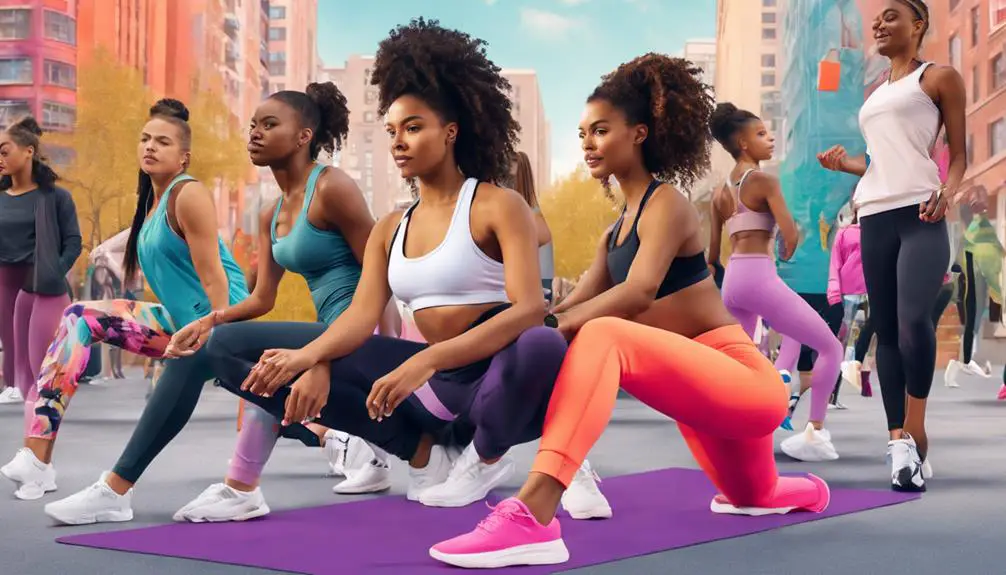
You've probably noticed how athleisure culture has transformed the way we think about fashion, seamlessly blending comfort with style in our everyday lives. Emerging in the late 20th century, this trend has sparked innovation among key industry players like Lululemon and Adidas, who continually adapt to meet consumers' evolving tastes. The influence of iconic brands like Adidas, with their rich history and vintage logo significance, has played a vital role in shaping this landscape. As sneakers outpace dress shoes and sustainability becomes a priority, the cultural impact of athleisure is undeniable, reshaping not just wardrobes but also our approach to fashion itself.
Evolution of Fashion Trends
The rise of athleisure culture marks a significant shift in how we approach fashion, blending the lines between workout gear and everyday wear. This evolution has roots in the late 20th century when designers like Donna Karan introduced interchangeable wardrobes, paving the way for the stylish yet functional sportswear we adore today. With innovations in fabrics like Lycra and Gore-tex, activewear transformed into a go-to choice for comfort and versatility.
As athleisure continues to thrive, you can expect to see:
- A fusion of athletic and casual styles, perfect for any occasion.
- Sneakers overtaking traditional dress shoes in popularity.
- Designers crafting collections that prioritize both function and flair.
- Increased consumer demand for versatile clothing that supports an active lifestyle.
- Athleisure's market valuation skyrocketing to $300 billion, showcasing its significance.
Incorporating athleisure into your wardrobe means embracing fashion trends that prioritize comfort without sacrificing style. As you explore these fashionable options, you'll discover how this trend reflects a broader cultural shift, allowing you to move seamlessly from gym sessions to brunch dates while looking fabulous every step of the way.
Key Industry Players
As athleisure culture continues to reshape the fashion landscape, key industry players are stepping up to meet the growing demand for stylish yet functional activewear. Major brands like Lululemon, Athleta, and Adidas dominate the market, which is valued at around $300 billion and expected to expand further. They're not just offering comfort but also innovative designs that cater to your active lifestyle.
Emerging brands like Girlfriend Collective and Wone are gaining traction, emphasizing sustainability by using recycled materials, reflecting a significant market trend towards health and environmental consciousness. You'll find that consumer preferences are shifting; sneakers are projected to surpass dress shoes in U.S. footwear sales, highlighting the desire for versatility in your wardrobe.
Key designers, such as Donna Karan, have paved the way by introducing innovative concepts like interchangeable wardrobes back in the 1980s. Today, market trends reveal a slowdown in sales growth but also a shift towards workplace-appropriate cuts and looser styles that seamlessly blend gym wear and business attire. In this ever-evolving landscape, the connection between comfort, style, and sustainability defines the future of athleisure and activewear.
Cultural Impact Overview
Athleisure culture has transformed how we view fashion, merging athletic wear with everyday styles. This trend has blossomed into a $300 billion industry, driven by your desire for comfort and versatility. Designers like Coco Chanel and Donna Karan laid the groundwork, leading to a broad cultural acceptance of sportswear outside of traditional athletic settings.
As sneakers have become the footwear of choice, surpassing dress shoes in popularity, athleisure reflects a lifestyle that prioritizes both style and physical activity. Brands like Lululemon and Girlfriend Collective are not only key players; they also emphasize sustainability, catering to health-conscious consumers like you.
Here are some key points about the rise of athleisure culture:
- Athleisure combines function and fashion seamlessly.
- Consumer demand drives innovation in sportswear design.
- Comfort is now a priority in everyday clothing choices.
- Sneakers symbolize the shift toward casual, multifunctional footwear.
- Athleisure promotes a healthier, more active lifestyle.
In embracing athleisure, you're participating in a movement that celebrates both personal style and well-being, making it a defining aspect of contemporary fashion.
Key Designers and Innovations
Activewear has evolved considerably over the decades, thanks in large part to visionary designers and groundbreaking innovations. Claire McCardell, often hailed as America's greatest sportswear designer, introduced versatile creations like the Monastic and Popover dresses, masterfully blending casual fabrics with stylish designs. In the 1980s, Donna Karan revolutionized activewear by developing interchangeable wardrobes that met contemporary women's desires for practicality and style, emphasizing comfort without compromising on fashion.
The introduction of Lycra in 1958 marked a significant turning point, as it allowed activewear to offer unparalleled comfort and performance. Designers like Rudi Gernreich made waves in the 1960s with bold swimsuit designs that pushed the envelope of functionality, proving that sportswear could be both practical and chic.
Innovations such as machine-knitting and the inclusion of functional pockets have further enhanced wearability, catering to the ever-evolving demands of active consumers. These key figures and their innovations have paved the way for a dynamic activewear industry, where comfort, functionality, and style come together to create the perfect ensemble for any activity. You can thank these trailblazers for shaping the activewear landscape we enjoy today!
Market Trends and Influences

As you explore the world of activewear, you'll notice how consumer preferences are constantly shifting towards comfort, style, and sustainability. Major brands are responding to these trends by incorporating eco-friendly materials and innovative designs that cater to your desire for versatile pieces that fit seamlessly into both your workout and daily life. This mirrors the evolution seen in the tattoo industry, where transforming perceptions of tattoos has influenced how body art is embraced in fashion. Plus, advancements in technology are enhancing performance and style, making it an exciting time to be part of the athleisure movement!
Evolving Consumer Preferences
Over the past few years, consumer preferences have considerably shifted towards active-inspired clothing that seamlessly combines comfort and style. The athleisure market, valued at a whopping $300 billion, reflects this trend, as more people prioritize versatility in their wardrobe. You'll find that brands are adapting to these evolving consumer preferences by offering innovative designs and multifunctional apparel that work just as well in the office as they do at the gym.
Consider these key shifts in the market:
- Increased demand for workplace-appropriate athleisure cuts
- Looser styles that bridge the gap between gym wear and business attire
- Sneakers projected to outpace traditional dress shoes in sales
- A rise in brands focusing on environmentally-friendly options
- Growth opportunities in footwear due to market saturation with stretchy pants
With these trends, it's clear that comfort and versatility are at the forefront of modern fashion choices. As consumers seek clothing that accommodates their active lifestyles while still looking stylish, the industry continues to reshape itself to meet these dynamic needs, creating a vibrant landscape for both buyers and brands.
Sustainability in Activewear
In recent years, the shift toward sustainability in the activewear market has become unmistakable, with brands prioritizing eco-friendly practices to attract conscious consumers. You might notice companies like Girlfriend Collective using recycled materials to create stylish, functional pieces that resonate with eco-conscious shoppers. This growing trend reflects a larger movement, as approximately 66% of consumers are willing to pay more for sustainable products.
The athleisure market, valued at a staggering $300 billion, is increasingly integrating sustainable practices in design and production, aligning with consumer preferences that emphasize health, wellness, and environmental responsibility. Innovations in sustainable fabrics, including those made from recycled polyester and organic cotton, are now common in activewear collections, driving market growth and setting new standards.
Major retailers and brands are stepping up their commitment to sustainability initiatives, actively working to reduce waste and carbon footprints as part of their corporate responsibility efforts. By choosing activewear that prioritizes sustainability, you're not only enhancing your wardrobe but also supporting a movement for a healthier planet. Embrace this change, and feel great about your choices!
Impact of Technology
Innovation has transformed the landscape of activewear, making it more functional and appealing than ever. With advancements in technology, today's activewear combines comfort, stretch, and performance like never before. You'll find yourself enjoying the benefits of high-quality materials that adapt to your lifestyle, whether you're hitting the gym or simply running errands.
- Temperature-responsive fabrics adjust to body heat, providing peak comfort during workouts.
- Waterproof yet breathable materials, like Gore-tex, keep you dry in unpredictable weather.
- Lycra and Du Pont Dacron have enhanced stretch and flexibility in activewear.
- Brands are increasingly focusing on sustainability, utilizing recycled materials.
- The athleisure trend is booming, with a market valued at $300 billion.
As you embrace these innovations, remember that your choice in activewear can reflect your values, including a commitment to sustainability. With sneakers expected to outpace dress shoes in sales, it's clear that consumers are prioritizing comfort and versatility. The evolution of activewear isn't just about looking good; it's about feeling great, adapting to your needs, and contributing to a more sustainable future. Join the movement and experience the difference technology has made in your active lifestyle!
Cultural Impact of Activewear
Activewear has transformed into a cultural phenomenon, merging comfort and style in ways that resonate with today's lifestyle. The rise of athleisure reflects a significant cultural shift, as you can now confidently wear comfortable clothing in social and professional settings. With the activewear market valued at an impressive $300 billion, it's clear that consumers are prioritizing health-conscious choices and versatile clothing options that seamlessly adapt from fitness to leisure. Brands like Quiksilver, which began by focusing on innovative designs and quality in surfwear, have adapted to these trends by expanding their offerings to encompass a broader range of active lifestyle apparel, reflecting the evolving needs of consumers in the activewear space Quiksilver's innovative designs.
Sneakers, once reserved for workouts, have gained immense popularity, projected to surpass dress shoes in U.S. footwear sales. This trend highlights a clear preference for comfort and functionality in your everyday life. Major brands like Lululemon and emerging players like Girlfriend Collective emphasize not only style but also environmental consciousness, demonstrating that you can look good while being mindful of the planet.
The fashion industry's adaptation to these health-conscious trends showcases a commitment to promoting comfort as a key component of style. As a result, you'll find that activewear isn't just about working out; it's become a staple of modern wardrobes, allowing you to express yourself while embracing a more active, balanced lifestyle.
Sustainability in Activewear
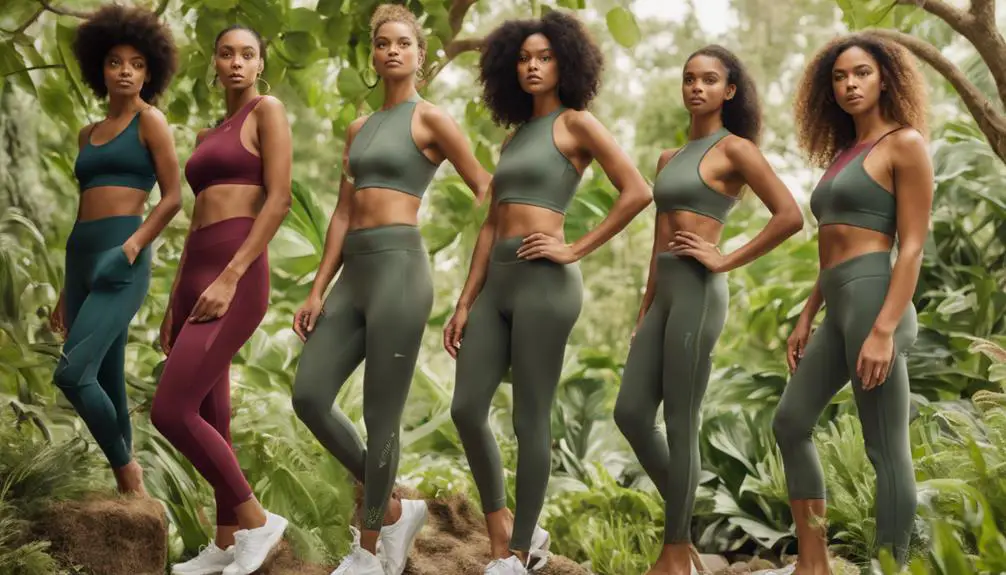
Sustainability is becoming a key focus for many activewear brands, reshaping the industry in profound ways. You'll notice that consumers are now prioritizing eco-friendly options more than ever, with a recent study revealing that 67% consider sustainability when making purchases. This shift in preferences isn't just a trend; it signals a growing demand for responsible manufacturing practices and materials that have a lower environmental impact.
Activewear brands are stepping up to meet this demand by incorporating recycled materials and innovative techniques. Here are some exciting developments you should know about:
- Brands like Girlfriend Collective are creating products from recycled plastics.
- Major players like Adidas are committing to using only recycled polyester by 2024.
- Bio-based fabrics and waterless dyeing methods are reducing waste and water usage.
- The market for sustainable activewear is projected to hit $300 billion by 2025.
- Consumers are actively seeking brands that align with their values of health and sustainability.
With these changes, the activewear industry is not just about performance; it's about creating a positive impact on the planet. Embrace this eco-friendly evolution and make informed choices in your athletic wardrobe!
Future of Athletic Fashion
As the demand for eco-friendly options reshapes the activewear landscape, the future of athletic fashion is set to be just as transformative. You can expect a surge in customization options, with 3D-printing technology enabling personalized fits and styles that cater to your unique preferences. Imagine slipping into gear designed just for you!
Innovations in augmented reality will also play a significant role, enhancing your training experience by providing real-time feedback during workouts. This tech-driven approach will help you optimize your performance like never before.
Temperature-regulating fabrics are on the horizon, adapting to your body's fluctuations to guarantee maximum comfort in any environment. As the athleisure market continues to thrive, projected to reach $300 billion, you'll find versatile, functional clothing that seamlessly shifts from fitness to daily life.
Moreover, the shift toward sustainable materials is gaining momentum, reflecting a collective desire for eco-friendly clothing that minimizes environmental impact. With these advancements, the future of athletic fashion promises to be not only stylish but also responsible, allowing you to express your individuality while contributing to a healthier planet. Get ready to embrace a new era of activewear!
Frequently Asked Questions
Where Did Activewear Originate?
Activewear originated in the 19th century, evolving alongside fitness culture. You'll find vintage workout styles utilizing athletic fabrics, designed for outdoor activities and gym aesthetics. This evolution shaped performance gear for activities like yoga and sports.
What Is the History of Athleisure?
Did you know the athleisure market's valued at around $300 billion? Athleisure trends thrive on celebrity endorsements, fabric innovations, and fitness culture, shaping consumer preferences and enhancing lifestyle branding across global markets.
How Did Sportswear Become Fashionable?
Sportswear became fashionable through celebrity endorsements and marketing strategies that highlighted fitness trends. Cultural shifts towards wellness, combined with advanced fabric technology and social media's influence, transformed athletic wear into a trendy lifestyle choice you can embrace.
What Is the Difference Between Sportswear and Activewear?
Activewear focuses on athletic performance with specialized materials, while sportswear emphasizes fitness fashion and lifestyle integration. As workout trends evolve, brands adapt to consumer preferences, blending both styles for versatile, everyday wear.
